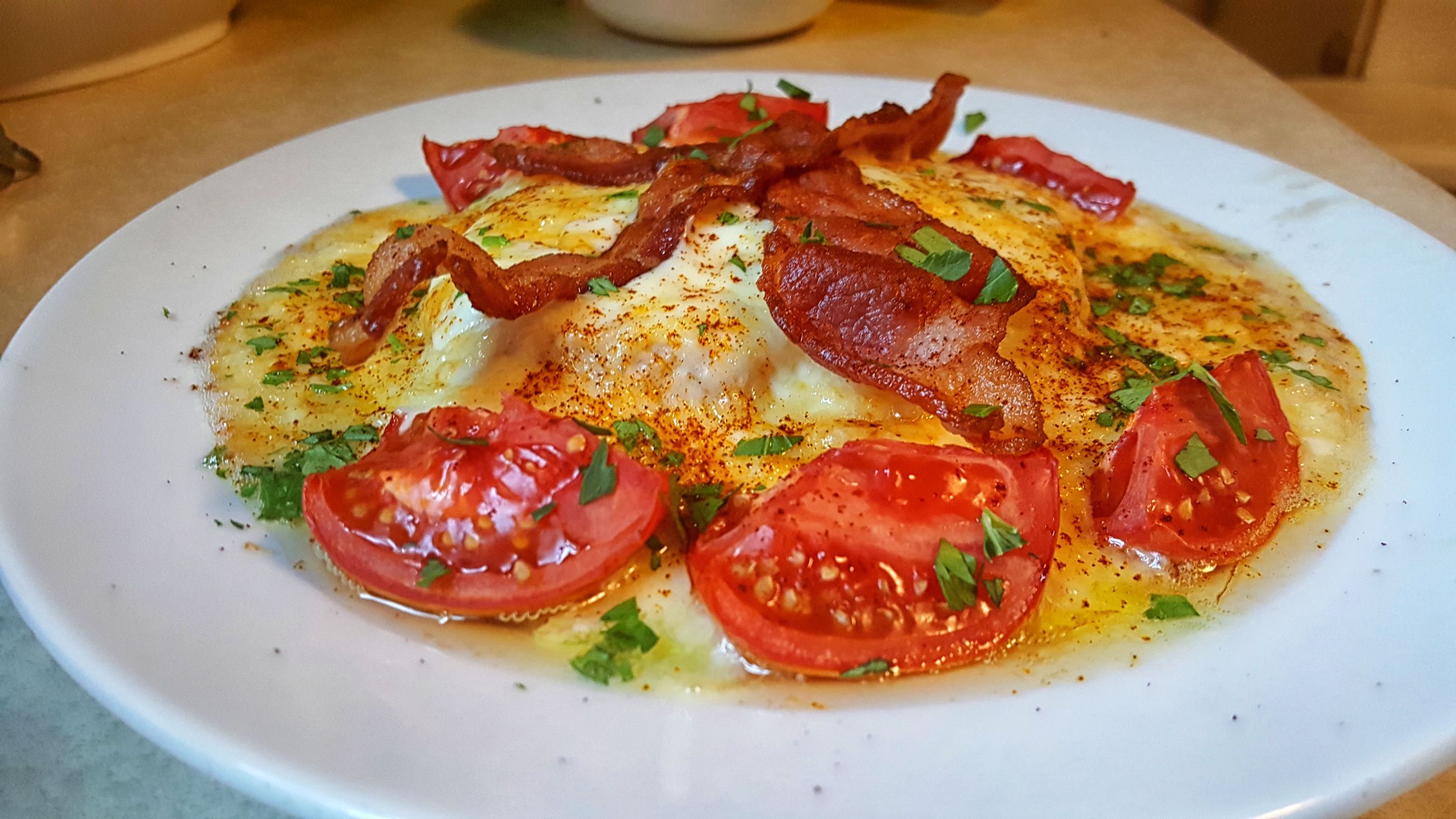But I’m a Crepe, I’m a Wiener
Sausages enveloped in some kind of flatbread–baked inside a pastry shell or a bread roll, wrapped in pancakes, steamed in a yeasted dough or simply dipped in some kind of batter and fried–are somewhat universal. Sausage rolls featuring seasoned minced meat wrapped in pastry and baked are popular throughout the British Commonwealth, Ireland, Africa. Countries all over Europe have similar dishes–Wurstbrötchen in Germany, worstenbroodje in Belgium. Dumplings and other bready vessels filled with highly seasoned meat mixtures are popular across Asia, from the manti of Turkey to the mandu of Korea. And of course, there couldn’t be anything more universal in America, from the Midwestern corn dog to the Texan kolache (itself based on the Czech Klobasnek) Other parts of the US have “pigs in a blanket,” which can be “little smokies” or sometimes just plain hot dogs wrapped in crescent roll dough from a tube and baked.
Sometimes though, at least in my experience, “pigs in a blanket” can mean breakfast pork sausage links wrapped in pancakes, and that is the first thing that the Galette-saucisse of northwestern France made me think of. Galette as a culinary term in France generally means a kind of rustic handmade pie or pastry, where a crust is topped with fruits or other fillings and then the edges are folded up and over to help contain the filling while it bakes. In Brittany, though, a galette–called a Breton galette sometimes to differentiate it from the more common kind–is a type of crepe or pancake, made with a buckwheat batter that may or may not also contain some wheat flour. And galette-saucisse, sometimes called robiquette, is one of these Breton galettes wrapped around a pork sausage. They are served as a street food in Brittany–from food trucks outside of football matches, during parades or festivals or other public celebrations.
“Pork sausage” is generally as descriptive as the writeups get. What kind of pork sausage? They do not specify, in the manner of a culture that knows very well exactly what kind of sausage goes in a galette-saucisse and is unbothered by the thought that someone else might not. Probably not a Wiener–the title of this post was just a play on some Radiohead lyrics, and of all the photos and videos I’ve seen containing Galette-saucisse, few if any of them appeared to be using anything resembling a hot dog-style sausage. Some descriptions of specific versions of the dish mentioned Toulouse sausages, or Montbéliard, or chipolatas. Youtube videos about Galette-saucisse are, generally speaking, in French, which has not clarified things for me, though I was amused to learn that one of the fight songs for the football club in Rennais is called “Galette-Saucisse, I love you.”
There seemed to be no overall consensus on what sausage to use for these, so I tried making my own chipolata for attempt #1.



These sausages were bratwurst-like, spiced with garlic and black pepper, allspice and mace, though I added some red wine and tarragon to give them more of a French character. I stuffed them into sheep casings, giving them a diameter similar to the typical American breakfast sausage rather than the thicker profile of the Wisconsin-style bratwursts I’m used to, but I separated them into links between 8 and 10 inches long to better fit the galettes my 12″ crepe pan would create. The basic sausage recipe I used is here.





The galette recipe I chose to use, which I found here, I picked because it used 100% buckwheat flour, making these galettes completely gluten free. I don’t personally keep to a gluten-free diet–that would be difficult for someone who likes sandwiches the way I do–but there are people in my life whom I love who do eat strictly gluten-free diets and it felt good to finally make something they’d be able to enjoy. My initial attempts at cooking the galettes yielded uneven results, but I’ve read the sort of pockmarked, blistered surface you can see in the image above is typical of the Breton galette.





Of course I had to try making the Galette Complète that was included in the galette recipe linked above. I separated the egg white and yolk to give it more of a sunny-side up appearance and used a mature English cheddar for the cheese and I could get used to this.



According to many sources I’ve read, Galette-saucisse purists insist that it should contain nothing but the sausage and the galette, so that is how I initially approached one. Unsurprisingly, with little else to distinguish this version, its quality will rely largely on the flavor of the sausage, and my chipolatas were up to the task. The sausage had sweet notes from the allspice, the mace, the tarragon, but was salty and savory with a nice kick of black pepper and garlic and plenty of pork fat, which is a sausage’s secret weapon. The buckwheat crepe was soft and flexible but pulled apart easily given the lack of gluten to give it resilience and structure. With the thinness of the chipolata, the galette became almost an equal partner in the flavor, and its earthy, nutty flavors complemented the sweetly savory sausage well.
But most of the videos I’ve seen did use a thicker sausage, and I happened to notice last week that Publican Quality Meats was selling Toulouse sausages, so I picked up a few and tried my hand at more of a stadium-style Galette-saucisse. Since my first batch, I had acquired a cookbook of recipes from Brittany, and the galette recipe it contained was not the 100% buckwheat version I’d been making but rather 80/20 buckwheat and wheat. The galettes I made using this recipe, not gluten-free, were more resilient than the all-buckwheat galettes and lighter in color, more similar to what I’d seen in many of the videos I watched about Galette-saucisse. They were also more prone to browning and stiffening up in the pan. They were also easier to handle, the batter spread more easily across the crepe pan and I could make much thinner galettes as a result.




The Toulouse sausages were not altogether different from my chipolatas–thicker, stuffed into hog casings rather than sheep casings; pinkish from the use of nitrites; but flavored similarly, mild and savory and warm. I’ve read that Dijon mustard and caramelized onions are a typical accompaniment for a Galette-saucisse despite the purists’ protests. I’ve seen in videos of Galette-saucisse being made and sold outside of sporting events that cheese or even ketchup is often added as well. I chose to use Dijon and a caramelized onion jam that I’ve had unopened in the fridge for a few months, waiting for its chance to shine.




With shorter sausages, the galette is usually doubled over and then wrapped around the sausage. I like tucking the sausage inside the fold so that it stays in place better, and wrapping in wax paper or parchment is smart when adding condiments, as they can start to disintegrate the crepe, especially one that’s made with 100% buckwheat instead of a buckwheat / wheat flour mix.

I like this method of serving sausage, and though I don’t expect it to take off in the US any time soon–it has the strikes against it of being French (too fancy) and the appearance of being potentially healthy (though the carbs in a 12″ crepe and a hot dog bun are approximately the same), making it an unlikely street- or stadium-food. But if you like sausages, or crepes, or sausage-like meats stuffed into bready objects in general, or if you can’t eat gluten, I think that you probably ought to give Galette-saucisse a shot.

I like sandwiches.
I like a lot of other things too but sandwiches are pretty great











First, great headline! Second, thank you for reminding me that buckwheat crepes exist and that recipes to make them can be found! There was a restaurant in San Francisco (the late lamented Ti Couz) that specialized in these crepes (and cider), and I wasn’t able to find decent recipes to recreate them years back. Will definitely try again.
That’s great, glad I was able to help! And you remind me that I read they are often paired with cider, and in fact I did buy some cider to drink with these but ended up mostly making and eating them for lunch on work days so the cider remains undrunk. I assure you though that the cider will not go to waste 🙂